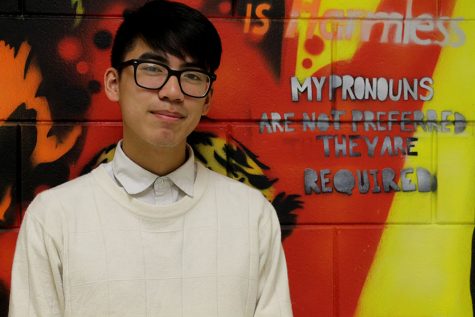Should Asian-American applicants affirm affirmative action?
“A big part of education is—beyond the academic aspect—being around people of different backgrounds,” South High senior Desmond LaFave stated. “Affirmative action makes sure that there are people from different backgrounds and that education is more accessible to those people.”
This year, I am going to be one of the tens of thousands of students who are applying to Harvard University as a first-year undergraduate; with a diversity of experiences, intellects, and identities, these students comprise the most competitive applicant pool among Harvard’s elite peers and even among Harvard’s own history. However, a specific kind of student seems to be attracting substantial media attention this year: Asian-Americans.
In 2014, Edward Blum— the litigant who has legally challenged the affirmative action policies of several universities prior —introduced a lawsuit against Harvard for violating federal civil rights law against Asian-American applicants. Although the case was dismissed in 2015, the case was reopened in 2017 under the Trump administration’s Department of Justice.
Blum alleges that colleges should not be race-conscious when evaluating the backgrounds of potential students; his belief is that policies that consider race infringe upon the principles of equality that colleges were sworn to teach, serve, and uphold, specifically by negatively affecting Asian-American students in the admissions process.
Today as students apply for admission into the 2019-2020 school year, Blum’s case remains extremely controversial among high school and college students alike, with many Asian-American students feeling that the case speaks to their personal upheavals in the application process while non-Asian minority students feeling that affirmative action policies are necessary to address structural inequalities and create diverse student bodies on college campuses.
“My media feed became crowded with Asian-Americans calling for the repeal of affirmative action, blaming other minorities for taking their spots, engaging in discursive tactics normally used by far right wing organizations and politicians,” South High senior Marie Stebbings described. “The lack of regard the Asian American community was showing for everyone but themselves inspired a deep sadness within me.”
Affirmative action policy isn’t new, nor is affirmative action policy exclusive to college applications. Ever since two executive orders passed by President John F. Kennedy and President Lyndon B. Johnson in 1961 and 1965 respectively, the term “affirmative action” has been defined and enacted towards the reduction of discrimination in employment processes.
For decades, affirmative action policies have sought to encouraged the opportunities of minority groups across the board—whether it be government, employment, or college admission—in order to level the playing field for those whom face disadvantages—both past and present—that block them from accessing equality of opportunity.
“A big part of education is—beyond the academic aspect—being around people of different backgrounds,” South High senior Desmond LaFave stated. “Affirmative action makes sure that there are people from different backgrounds and that education is more accessible to those people.”
“If I was in a school where everyone came from… similar upbringing,” LaFave said. “There wouldn’t be other people there to challenge what everyone is thinking and give their own opinions based on their experiences.”
“[Colleges] want people of different races, ethnicities, religions to foster education together because when people of different cultures create dialogue, it’s meaningful,” South High senior Eiset Mebrahtu said. “[Diversity] helps your own intellectual growth.”
After all, minorities—especially Black and Indigenous minorities—have been long disenfranchised, intergenerationally impoverished, and denied access to institutions throughout American history. Therefore, their ability to compete among other applicants—whether it be a job, a college admission, or a government position—is inherently reduced.
“Affirmative action or race conscious admission policies allow colleges to take into account race when admitting students,” Stebbings explained. “This leads to a few things.”
“First, [affirmative action leads to] more holistic approaches to applications,” Stebbings said. “Race is an integral part of a student’s identity, and condensing everything into a weird race neutral landscape denies that.”
“Second, [affirmative action] forces universities to be more aware what the incoming freshman class is going to look like,” Stebbings continued. “[Affirmative action] holds [colleges] accountable to diversity and not just admitting a s*** ton of white students.”
Although the statistics do paint a picture that non-Asian minorities have better admissions chances than Asian-Americans, knowing the context is very important; only by understanding the socioeconomic conditions of Asian-Americans as they are today can students can a more accurate picture of why college admissions function the way that they do.
“As an East Asian American, I have always been told—and always known—that the college application process will be an ‘uphill’ battle.” Stebbings reflected. “Because East Asian Americans are a minority within the US—but so many of us are socioeconomically advantaged (which is then reflected in test scores, GPAs, extra curriculars, etc.)—East Asian Americans are often portrayed as fighting each other to get in to elite colleges, and sadly that is somewhat the reality.”
Stebbings refers to the ways in which, although Asian-Americans are considered a demographic minority in the United States—comprising 5.6% of the population, according to the United States Census Bureau—statistics show that Asian-Americans—specifically East Asians—have an average household income of $73,060 according to the Pew Research Center, which is $19,460 higher than the national average of $53,600.
Since being more affluent generally has an effect on the educational opportunities open to students, the result is that more Asian-Americans—specifically East Asians, given the skew in the household income data—enter college. According to the United States Census Bureau, 54% of Asian-American population hold bachelor’s degrees, which far outnumbers any other racial and ethnic group in America and is well-above the national average of 33%.
“People think that they are more ‘high-qualified’— according to test scores and grades —Asian-Americans that are applying to Harvard and not getting in,” LaFave explained. “So, they say that there’s a higher standard for Asians getting into Harvard.”
To colleges, Asian-Americans are considered an “overrepresented minority.” In order for affirmative action policies to level the playing field, more non-Asian minorities must be admitted into a student body, which might come at the (debatable) expense of the excess of Asian-American students that apply and receive admission.
“I think the idea that affirmative action necessitates discrimination against Asian American is a fault of the quota system,” Stebbings explained. “The idea should not be that you need to admit X number of students and then you have fulfilled your ‘diversity quota,’ but that students should be evaluated on every part of their application and identity.”
“You shouldn’t have a quota on how many Black people you need to fulfill your admissions requirements,” Mebrahtu said as an example. “That’s ridiculous.”
“When it comes down to it, a couple of Asian Americans who statistically should have been admitted not being admitted is an easy sacrifice to make for the greater good,” Stebbings adjudicated. “Especially when Asian Americans benefit in so many other ways from the model minority myth.”
According to critical race theorists, the term “model minority” refers to people who—although are minorities and face discrimination—seem to have socioeconomic success above the average. Given the Pew Research Center and United States Census Bureau data cited above, Asian-Americans are statistically constructed to be the “model minority” of the United States.
“The model minority myth structures how American society as a whole sees East Asian Americans, allowing them access to greater opportunities in terms of school, employment, etc.” Stebbings defined. “Asian Americans are raised as the minority group that every other minority should aspire to be … which results in other minorities being denigrated for ‘just not working hard enough.’”
“It’s a result of American immigration policy where only the most ‘elite’ of Asians were admitted into the United States,” Stebbings explained. “Historically … only people like doctors, scientists, and students were admitted into the United States, which resulted in the building of a strong upper-class East Asian community.”
The model minority myth influences the college admissions process by generalizing Asian-Americans as socioeconomically successful across the board and, therefore, deserving sanctions in the college admissions process.
Stebbings argues that Asian-Americans shouldn’t be angry towards the college admissions process for upping the standard for admission. Rather, Asian-Americans should focus their criticisms against their stereotyping as generally successful, from which the alleged “discrimination” against Asian-American applicants is based upon.
“There’s truth in the claim that [Asian-Americans] have been discriminated in college admissions,” Mebrahtu said. “Again, it has to do with the system.”
“Instead of engaging anti-Black solutions like the Harvard affirmative action case,” Stebbings said. “Asians need to work to deconstruct the model minority myth and support their fellow people of color in a collective struggle for equality through equity.”
As high school seniors enter what might be considered the most competitive years for college admission, the question of affirmative action seems to take center-stage in our discussions of how to navigate the college process, especially for students who come from disenfranchised and dispossessed backgrounds where the prospect of college may feel slim.
While some Asian-American students hope that Blum can streamline the application process, many fear that the civil rights gains of the past may be reversed if Blum wins the case. In a process where any and every factor can make or break an application, prospective college students are currently caught at the edge of their seats waiting for the case to progress.
As we submit applications this year and hope for acceptance letters from our “dream schools” and top colleges, we might be able to bear witness to history in the making as Blum challenges one of the most prestigious colleges in the world at the highest level of American government in the Supreme Court with what political analysts and legal scholars call the most influential affirmative action case in history.

Senior B Fei, a Staff Writer on the newspaper since the beginning of this school year, can be found sporting a myriad of sweaters and wearing their signature...

